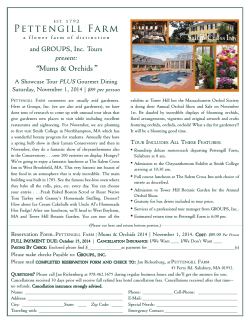
St. Augustine Orchid Society What is an Orchid Species?
St. Augustine Orchid Society www.staugorchidsociety.org What is an Orchid Species? by Sue Bottom, sbottom15@bellsouth.net The first time I was asked the question “what is a species?”, I mumbled something incomprehensible. You may intuitively know what a species is, but putting a definition next to the word is easier said than done. A traditional definition of species is a population of similar individuals that interbreed but are reproductively isolated from other populations. Geographical Isolation. A population of orchids can be reproductively isolated if it is separated from other populations by land or water masses. A simple case of too great a distance between populations can prevent them from interbreeding. Ecological Isolation. A species of orchids can be reproductively isolated from others if it grows in different habitats within a given geographical area, such as those growing in shade or sun, low or high in the tree canopy, etc. or if it has different pollinators. Seasonal Isolation. The season of bloom can be an important distinction between species because it is one of the ways in which a population can be reproductively isolated. If one species blooms in the spring and the other in fall, they don’t have an opportunity to interbreed. Genetic Incompatibility. Orchids of different species within the same genus can interbreed easily and many genera within a given orchid subtribe can produce viable seed when they cross pollinate. But if the genetic differences are too great, two orchid populations growing in the same habitat with the same blooming season cannot interbreed and remain two distinct populations. Taxonomists make distinctions between different species based on a host of things they look at, including the floral structure, particularly reproductive structures, the plant’s morphology, growing and flowering habits, and sometimes even DNA analysis. Often there are minor variations within a species, such as flower color, size, etc. that are not extreme enough to be given subspecies designation so they are considered to be varieties of a species. The wide ranging Australian species Dendrobium speciosum is considered to be a single species despite it having nine separate varieties with different blooming periods, ecological niches, flower color, etc. The many prized color forms of Laelia purpurata are a good example of natural variation than can occur within a species. Some of the Many Color Forms of Laelia purpurata standard form carnea form striata from werkhauseri form schusteriana form The beautiful Laelia purpurata displays considerable variation in floral colors within the species photos by Terry Bottom Page 1 of 3 St. Augustine Orchid Society www.staugorchidsociety.org What is an Orchid Species? by Sue Bottom, sbottom15@bellsouth.net Hybridization between species does occur in nature when there is an overlap in the geographical location and flowering period of species that can crossbreed and produce viable seeds and sometimes fertile offspring. There are areas in Brazil where the habitats of Laelia purpurata (lowland coastal rainforests), Cattleya intermedia (coastal areas) and Cattleya leopoldii (syn. tigrina, lowland coastal swamps) overlap. Within these overlapping areas, naturally occurring hybrids are found, including Cattleya x elegans (C. tigrina x C. purpurata), Cattleya x intricata (intermedia x leopoldii), and Cattleya x schilleriana (purpurata x intermedia). Natural Hybrids Can Occur in Nature Where Species Habitats Overlap L. purpurata ‘Cindarosa’ C. leopoldii Lc. Elegans var. rubra The natural hybrid between L. purpurata and C. leopoldii is referred to as x elegans when created by Mother Nature and Lc. Elegans when created by man. photo credits: L. purpurata and Lc. Elegans by Terry Bottom, C. leopoldii by Keith Davis A hybrid swarm is a population of individuals that are all hybrids, consisting of primary hybrids between the parent species, various generations of backcrosses between the hybrids and parent species and crosses between the primary hybrids. The exchange of genetic material in the population, referred to as introgression, is primarily from backcrossing and this tends to blur the integrity of the parent species. Dr. Ruben Sauleda always said that what we call the highly variable species Encyclia tampensis is really a hybrid swarm between three species. Carlyle Luer states that genes from species like Encylia phoenicea and Encyclia plicata are present in Encyclia tampensis, even though the parent species are long gone from the wilds of the Florida peninsula. Sometimes new species arise when a species population evolves, converges and/or diverges and becomes genetically isolated from the parent species from which it arose. This has happened where populations of orchids evolve in a geologically active areas. When continental plates migrate or collide, the climatic conditions can also change and orchid populations adapt to wetter or drier, warmer or cooler, etc. conditions via natural selection and can result in the evolution of new species. Plate tectonics is one of the reasons for the incredible diversity in the species of dendrobiums and bulbophyllums found in the southeast Asia, the Malaysian Archipelago and Australia. Most of the angraecums evolved in Madagascar after the island separated from Africa. Page 2 of 3 St. Augustine Orchid Society www.staugorchidsociety.org What is an Orchid Species? by Sue Bottom, sbottom15@bellsouth.net New Species Develop as Continental Plates Drift and Collide Dendrobium goldschmidtianum Angraecum sesquipedale Pedilonum dendrobiums evolved into bird pollinated species as the Philippine, Asian and Australian plates migrated. Moth pollinated angraecums evolved on Madagascar after it separated from the African continent 95 million years ago. photos by Terry Bottom It’s simple for me to tell if an orchid is a species or not, I just look at the plant tag. Imagine what it would be like if you were looking at two populations of orchids in nature and trying to make a decision as to whether or not they are distinct species. You get a new appreciation for the taxonomists that study such things and sometimes change their minds about what orchid species belongs to which genus and what the proper name of that species might be. Page 3 of 3
© Copyright 2025





















